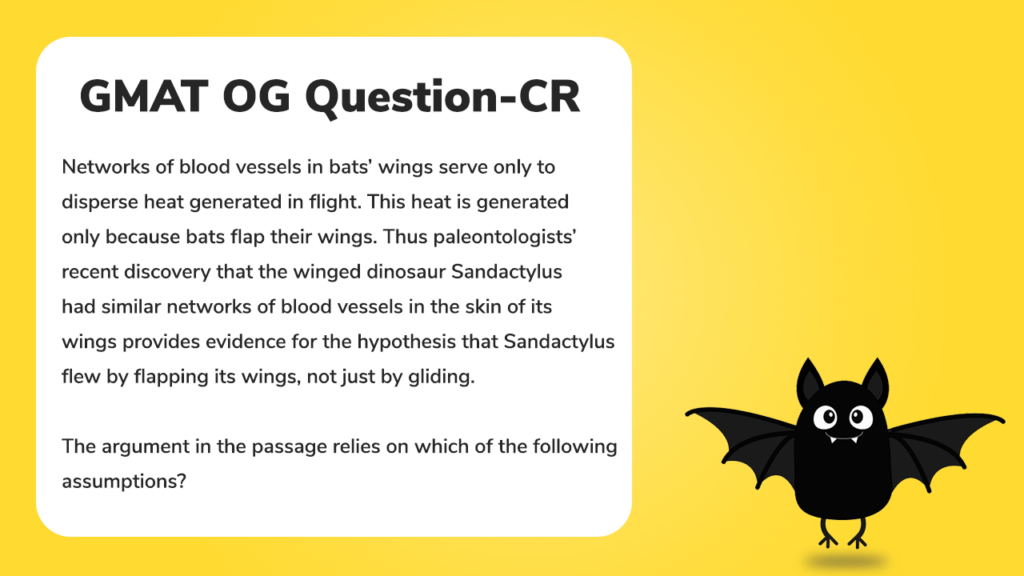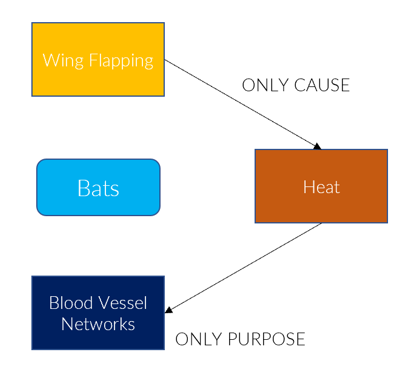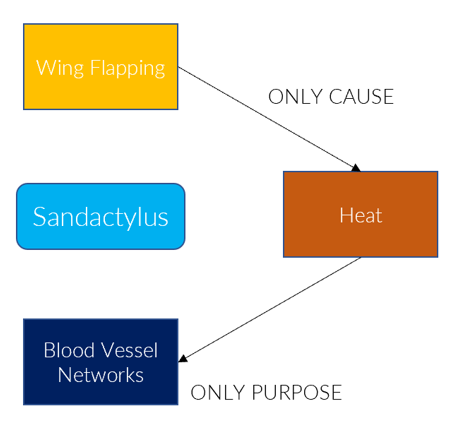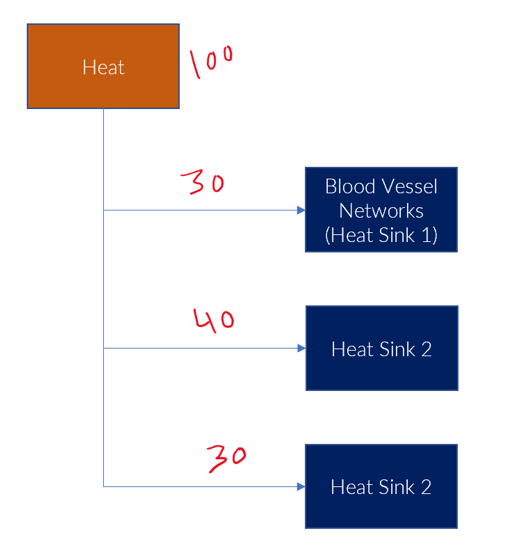In this article, we’ll look at the solution to this Official Guide (OG) question – “Networks of blood vessels in bats’ wings…”, also known as the “Sandactylus” question on critical reasoning.
Networks of blood vessels in bats’ wings serve only to disperse heat generated in flight. This heat is generated only because bats flap their wings. Thus paleontologists’ recent discovery that the winged dinosaur Sandactylus had similar networks of blood vessels in the skin of its wings provides evidence for the hypothesis that Sandactylus flew by flapping its wings, not just by gliding.
The argument in the passage relies on which of the following assumptions?
[Refer to GMAT Official Guide for options]
Here is some general information about this OG question:
- Difficulty Level: Hard
- Most Common Incorrect option choice: Choice B and Choice E
- Question Type: Assumption

OG Video Solution – Networks of blood vessels in bats’ wings…| Sandactylus
Begin your GMAT preparation with the most reviewed GMAT prep company on GMAT club, which has delivered more 700+ scores than any other GMAT club partner. Achieve GMAT 740+ with our AI driven tools that give you personalized feedback at every step of your GMAT journey. Take our free trial today!
OG Solution – Networks of blood vessels in bats’ wings…| Sandactylus
Hey folks, in this article, we are going to do a dissection of one of the all-time-great OG questions in Critical Reasoning. This is an oldie from OG11, one that is gangster enough to justify the obvious pun on “OG”.
This question has everything:
- A conclusion that is easy to get wrong.
- Logic that is deeper than it looks.
- A seemingly incorrect answer choice that is correct.
- Answer choices that seem correct but are incorrect.
As always, let’s begin by solving the question:
GMAT Official guide question: Networks of blood vessels in bats’ wings serve only to disperse heat generated in flight. This heat is generated only because bats flap their wings. Thus paleontologists’ recent discovery that the winged dinosaur Sandactylus had similar networks of blood vessels in the skin of its wings provides evidence for the hypothesis that Sandactylus flew by flapping its wings, not just by gliding.
The argument in the passage relies on which of the following assumptions?
Interesting question, am I right?
Now, let’s analyze the question in detail, and understand how each of the above four aspects can create chaos if one is not careful!
A conclusion that is easy to get wrong
Thus paleontologists’ recent discovery that the winged dinosaur Sandactylus had similar networks of blood vessels in the skin of its wings provides evidence for the hypothesis that Sandactylus flew by flapping its wings, not just by gliding.
Look at the word “hypothesis”. It typically refers to a theory of some sort, something not necessarily proven to be true. An unproven theory is a claim at the end of the day.
This may lead one to believe that what follows the word “hypothesis” is the claim being made in the argument.
Incorrect Conclusion: Sandactylus flew by flapping its wings (not just by gliding).
If you assumed the above statement to be the conclusion, then you may have fallen prey to the trap of looking at specific words (like “hypothesis”) to figure out the conclusion, instead of relying on the meaning being communicated.

Remember – you have no idea if the hypothesis that Sandactylus flew by flapping its wings is the author’s hypothesis/claim. The author only makes a claim linking a certain discovery (blood vessel networks) to a certain hypothesis (that Sandactylus flew by flapping its wings).
The hypothesis is that Sandactylus flew by flapping its wings (not just by gliding).
The author’s conclusion is that the recent discovery is proof/evidence which confirms the above hypothesis.
The correct conclusion is stated below.
Correct Conclusion: This discovery of blood vessel networks in Sandactylus is evidence/proof that Sandactylus flew by flapping its wings (not just by gliding)
Lesson 1
The main conclusion is the central claim being made by the author. Make sure that you distinguish the author’s claim(s) from any other claims or hypotheses in an argument.
Another observation – The keyword “thus” is a conclusion indicator that correctly identifies the conclusion in this case, while the word “hypothesis” can lead us astray if we are not careful.
Lesson 2
Any single word that indicates a possible conclusion is, at best, a rough indicator. Such words are not to be taken as confirmation of conclusion; we still need to rely on meaning and logic to identify the actual conclusion.
At this point, you may be wondering if such minute differences in a conclusion have any bearing on what answer one chooses. Well, it does! For example –
Option A: Sandactylus would not have had networks of blood vessels in the skin of its wings if these networks were of no use to Sandactylus.
If you considered the conclusion to be that Sandactylus flew by flapping its wings, you might have instinctively rejected option A, given that it is not even talking about flying or flapping of wings. You would be a bit more careful if you understood that the conclusion is about the blood vessel networks being evidence of flying by flapping wings.
Understanding what the correct conclusion is makes a lot of difference!
Logic that is deeper than it looks
Now that we have understood the conclusion, let us also deliberate on the logic used to arrive at the conclusion.

Bats have blood vessel networks in their wings. These networks have only one purpose – to dissipate the heat generated in flight. The only cause behind this heat generation is the flapping of wings for flying.
Now, paleontologists have recently discovered that a creature called Sandactylus also had similar blood vessel networks in its wings.
The author claims that this discovery is proof that Sandactylus also flew by flapping its wings (not just by gliding).
Observe the underlying logic
![Sandactylus... [GMAT OG Question]](https://cdn.e-gmat.com/blogs/wp-content/uploads/2021/12/sandactylus-use-logic-gmat-og-solution.png)
In Sandactylus, only the blood vessel networks have been discovered (that is why everything else in the image above is greyed out!).
But to make this conclusion, the author has considered (assumed) that the same mechanism seen in bats also applies to Sandactylus.

Only then can it be concluded that the existence of these blood vessel networks is proof that Sandactylus also flew by flapping its wings.
This is an example of an analogy being the logical basis of an argument. Something analogous to what has been observed for X is assumed to apply for Y also.
What makes the logic here deeper than it looks is the implication of “only”.
In bats, blood vessel networks exist only for dissipating the heat generated in flight, which in turn is only caused by the flapping of wings.
Let’s take an example – If in bats, blood vessel networks exist for several purposes, including dissipating heat generated by wing flapping, then the existence of similar blood vessel networks in another creature is not in any way indicative of that creature flapping its wings. The networks may have been there in the other creature for some of these other purposes, not necessarily for dissipating heat generated by wing flapping.
Similarly, if the heat generated by blood vessel networks in bats is not only due to wing flapping, then the existence of blood vessel networks in another creature is not in any way indicative of that creature flapping its wings. The networks may have been there to dissipate heat generated by some other activity, for all we know.
It is because of “only” that the author is able to make the conclusion in this argument. It is also this aspect that helps us with prethinking – for example, a statement that suggests that blood vessel networks in Sandactylus exist for some other purpose (thus breaking the “only” condition observed in the mechanism for bats) will effectively break the conclusion.
Prethinking
Falsification Question: In what scenario is the paleontologist’s discovery not evidence for the hypothesis that Sandactylus flew by flapping its wings, not just by gliding?
Think logically. The author’s logic entirely depends on the same mechanism applying to Sandactylus.
How do we break this? By proving that the same mechanism does not apply here!
Breaking the mechanism for Sandactylus
One way to do this is by breaking the mechanism for Sandactylus.
![Sandactylus... [GMAT OG Question]](https://cdn.e-gmat.com/blogs/wp-content/uploads/2021/12/networks-of-blood-vessels-in-bats-wings.png)
Some Falsification Conditions based on the above approach:
- What if the blood vessel networks in Sandactylus’ wings served a completely different purpose (from what we see with bats)?
Then, the existence of blood vessel networks cannot be considered proof of wing flapping.
Assumption: Blood Vessel Networks in Sandactylus did not serve some other completely different purpose.
- What if the blood vessel networks in Sandactylus’ wings served no actual purpose (unlike what we see with bats)?
Then, the existence of blood vessel networks cannot be considered proof of wing flapping.
Assumption: Blood Vessel Networks in Sandactylus did not exist without any actual purpose.
- What if wing-flapping did not lead to heat generation in Sandactylus (unlike what we see with bats)?
Then, the existence of blood vessel networks would not have been for dissipating heat generated from wing flapping. So, the existence of blood vessel networks cannot be considered proof of wing flapping.
Assumption: Flapping of wings would have led to heat generation in Sandactylus too, just like in bats.
Lesson 3
Pay attention to words like “only”. They usually have a significant impact on logic.

Option A: A seemingly incorrect answer choice that is correct
Let’s take another look at option A.
Sandactylus would not have had networks of blood vessels in the skin of its wings if these networks were of no use to Sandactylus.
This option is rejected by many students on the notion that it is describing a hypothetical situation.
The argument already tells us that Sandactylus had blood vessels. So, any option describing the hypothetical situation of Sandactylus not having these networks should be irrelevant to the argument.
Right?
Wrong! Though option A describes a hypothetical situation of Sandactylus not having the blood vessel networks, it cleverly conveys something about Sandactylus in real life too (which is easy to miss!).
What option A means:
Hypothetical situation being described => The blood vessel networks would not have existed if they had no use.
What can this tell us about the real situation?
Given the blood vessel networks did exist, they must have had a purpose, i.e., they did not exist without any purpose.
This is in line with our prethought assumption 2.
Negation Test on Option A:
Blood vessel networks could have existed in Sandactylus’s wings even without any actual purpose.
In such a case, the author cannot conclude that these networks are proof of Sandactylus flying by flapping its wings. These networks had no purpose – they had nothing to do with heat dissipation or wing flapping. Negated option A breaks the conclusion.
Lesson 4
Do not rush through answer choices. Even a hypothetical situation can convey information about the real situation. Read slowly and understand the implications of what is being conveyed by the answer choice. Do not rush and reject blindly.

Answer choices that seem correct but are incorrect
Options B and E are extremely popular incorrect choices, chosen by almost 60% of students typically. These are both extremely tempting option choices, that need to be analyzed deeply for us to be able to reject them.
The easiest way to eliminate these options is to apply the negation test. Both do not satisfy the Must-Be-True (MBT) characteristic of an assumption.
Option B: All creatures that fly by flapping their wings have networks of blood vessels in the skin of their wings.
For the conclusion to hold true, do we need each and every creature that flies by flapping its wings to have blood vessel networks in the skin of its wings?
No. As long as Sandactylus has these blood vessels to dissipate the heat generated by wing flapping, we do not need all creatures to even have such blood vessel networks – option B is not really needed for the conclusion to hold true.
But let us also apply the negation test.
Negated: Not all creatures that fly by flapping their wings have blood vessel networks.
In other words, there may be some creature, say X, that flies by flapping its wings but does not have blood vessel networks.
| Creature | Wing flapping for flight | Blood Vessel Networks in wings |
| Bats | Yes | Yes |
| Sandactylus | Claimed | Yes |
| X | Yes | No |
Negated option B simply tells us that there may be this other creature X that flaps its wings for flying but does not have blood vessels.
But we already know that Sandactylus has blood vessel networks. The fact that X does not have these networks tells us nothing about Sandactylus. For all we know, the blood vessels in Sandactylus may have been there for the singular purpose of dissipating heat generated by wing flapping. And so, the discovery of blood vessel networks may very well be proof that Sandactylus flew by flapping its wings.
Negated option B does not break the conclusion. It is not the correct answer.
Option E: Heat generated by Sandactylus in flapping its wings in flight could not have been dispersed by anything other than the blood vessels in its wings.
Negated: In Sandactylus, there could have been other mechanisms for the dispersal of heat generated by flapping of wings in flight.

For example, say there are two other heat sinks (entities that can be used for heat dissipation). Let us say that blood vessel networks typically dissipate 30% of the heat generated by flapping of the wings in flight.
Now, even if there are these two other heat sinks, and even if the blood vessel networks only dissipate 30% of the heat generated by the flapping of wings during flight, as long as the blood vessel networks exist in Sandactylus for only the singular purpose of dissipating this heat, the conclusion will still hold true.
What if the only purpose of the blood vessel networks in Sandactylus is to dissipate some of the heat generated (30%) by wing flapping during flight? In such a case, the discovery of these blood vessels would still be considered evidence that Sandactylus flew by flapping its wings.
In other words, negated option E does not break the conclusion. It is not the correct answer.
Lesson 5
Apply negation test for any answer choice that you cannot eliminate immediately and easily, in Assumption questions. Do not shy away from analyzing deeply.
I hope that you find this article and the lessons in it useful in your CR preparation!
Here is another question you should solve that has certain similar elements – a subtle meaning trap in the conclusion, as well as extensive use of the negation test.
If you want a deeper understanding of the negation test, this article can help you.
Happy Learning!
Harsha
If you are planning to take the GMAT, we can help you with a personalized study plan and give you access to quality online content to prepare. Write to us at acethegmat@e-gmat.com. We are the most reviewed GMAT prep company on gmatclub with more than 2200 reviews and are the only prep company that has delivered more than 700+ scores than any other GMAT club partner. Why don’t you take a free trial and judge for yourself?


![[OG Solution] Networks of blood vessels in bats’ wings…| Sandactylus](https://cdn.e-gmat.com/blogs/wp-content/uploads/2021/12/networks-of-blood-vessels-in-bats-wings-1.png)








